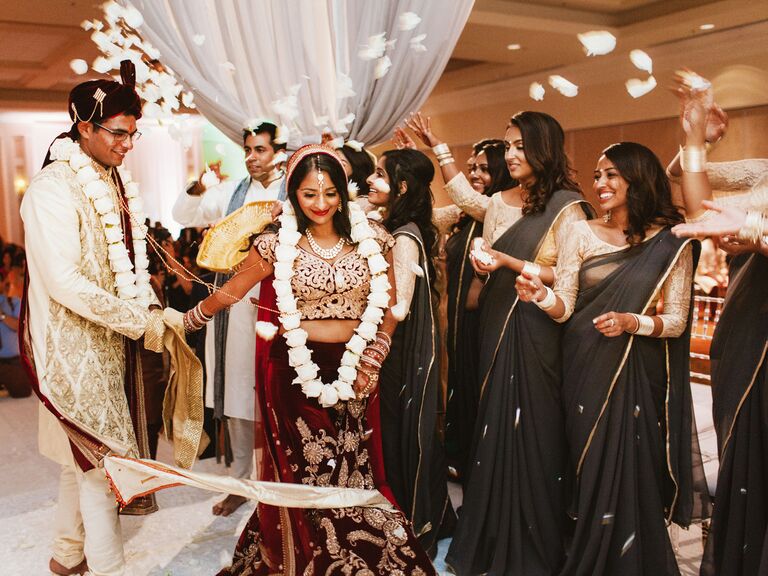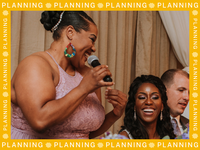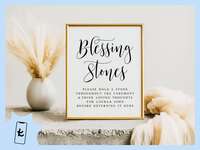The Ultimate Hindu Wedding Ceremony Program Checklist

It's no secret that attending a Hindu wedding is an experience filled with tradition and ceremony. These dazzling multi-day events bring friends and families together in joyful celebration, but some of your guests who haven't attended a Hindu wedding ceremony before might not be familiar with the different stages of the wedding or the specific rituals involved. While some Indian wedding ceremonies of different religions, like a Jain or Sikh wedding, may include elements similar to Hindu weddings, today we're taking deep-dive into crafting a Hindu ceremony program.
Beyond just the ceremony, Hindu weddings also include many pre-wedding events. However, most guests will not be present for family-centered ceremonies in the first days of an Indian wedding and may not need an explanation of those traditions, such as the Haldi turmeric ritual, the festive Sangeet, or the bride's Mendhi party where she'll have her henna done. Meanwhile, for day-of ceremonies and rituals where the rest of the guests will be present, it might help to outline some of the specific things that happen in a Hindu wedding ceremony in your wedding program to help guests follow along. You might include brief paragraphs describing the significance of the mandap, the copper kund where the sacred fire Agni Poojan is lit, or the meaning behind applying red powder called sindoor to the bride's part.
Helping your guests understand the significance of each part of the ceremony on a wedding card will help them appreciate and understand what they're witnessing and enjoy your special day all the more.
What To Include in a Hindu Wedding Program
Indian weddings are complex affairs, with abundant symbolism and numerous rituals to bless the couple's future together. While some elements of an Indian Hindu wedding may differ slightly by region, or by the couple's preferences, the essential elements to include in Indian wedding program are the following:
- Baraat: The groom's arrival, accompanied by the groom's family and friends. Traditionally done riding a white horse, but modern baraat processions can include everything from elephants to luxury cars.
- Milni: A pre-wedding Hindu tradition where the groom is met by the bride's parents and close friends. Gifts and sometimes food are presented to the groom including tokens of good luck, called shagun, or money. This is when the groom's soon-to-be mother-in-law applies the tilak, or red dot on the groom's forehead.
- Ganesh Puja: The priest says a blessing prior to the marriage ceremony beginning, asking the Hindu god Ganesh to bless the couple by removing any obstacles as they begin their new life together.
- Kanya Aagaman: The bride's procession. Traditionally, this is the bride's first appearance to anyone but her family on her wedding day. She is escorted by her family members as she makes her way to the mandap, or raised platform, where the ceremony will take place.
- Jai Mala: The bride and groom exchange brightly colored garlands, symbolizing their joining into each other's families.
- Kanyadaan: The parents of the bride bless the union and give away the bride.
- Laaja Homam: "The offering of puffed rice to the sacred fire." Rice is poured into the fire by the groom and the bride, assisted by a member of her family.
- Mangal Phera: The couple walks in circles, or pheras, around the sacred fire between four or seven times. To close the ceremony, the bride and groom will be literally knotted together by the scarves, or dupatta, that they wear.
- Mangalsutra: Performed before the ring exchange, the groom recites from the Vedas, and places a necklace around the bride's neck to symbolize her new status as a married woman and that they will be together until death separates them.
- Ring Exchange: An adopted part of the ceremony, the bride and groom will exchange wedding rings and may recite vows to each other.
- Saptapadi: Meaning "Seven Steps" in Sanskrit, the bride and groom will take seven steps together or complete seven circles around the sacred fire.
- Ashirwad: Final blessings bestowed upon the couple by family, elders, the priest, and others. Guests may shower the couple with rice or flower petals as a blessing to the couple.
Hindu Wedding Program Wording Examples
How in-depth you'd like your wedding program to be is up to you. You may wish to list every ceremony and wedding ritual in detail, or you may want just the highlights.
Examples of how you might word the entries in your Hindu wedding program are as follows:
- Kanya Aagaman: Like the groom has the baraat, the bride also has her own processional. She is escorted by members of her family up to the mandap where the ceremony will take place. The bride and groom traditionally do not see each other prior to the wedding ceremony. Up until the bride reaches the mandap, their view of each other is separated by a cloth called an antarpat. This symbolizes the couple's two separate lives. During an unveiling ceremony called muhurtham, the antarpat is lowered and bride and groom can see each other for the first time, symbolizing the bride and groom's two lives becoming one.
- Laaja Homam: Translated from the Sanskrit meaning, "the offering of puffed rice to the sacred fire" is an essential element of a Hindu marriage. After the Agni Poojan, or sacred fire, is lit, rice is poured into the fire by the groom and the bride, assisted by a member of her family. This wedding ritual is conducted to ask the Hindu god of fire, Lord Agni, to bear witness to the marriage and bless them with prosperity and happiness.
- Kanyadaan: A parental blessing meaning "giving away the daughter." The father of the bride will place the bride's right hand into the groom's right hand, symbolizing his acceptance and blessing of the union. The mother of the bride will pour water into the palm of the father of the bride, allowing it to flow through his fingers and onto the hands of the couple.
Where to Buy Hindu Wedding Programs
When it comes to actually designing and printing wedding programs, you must first consider how customized you want the programs to be. If you're looking for a ready-to-go semi-custom option, customizable options ready for purchase are aplenty on The Knot. However, if you're looking for a totally custom and personalized option, then it's a great idea to partner with a stationery vendor who can design all your paper needs, from wedding invitations to programs, for you. To find a great local vendor for the task, peruse The Knot Marketplace.




















